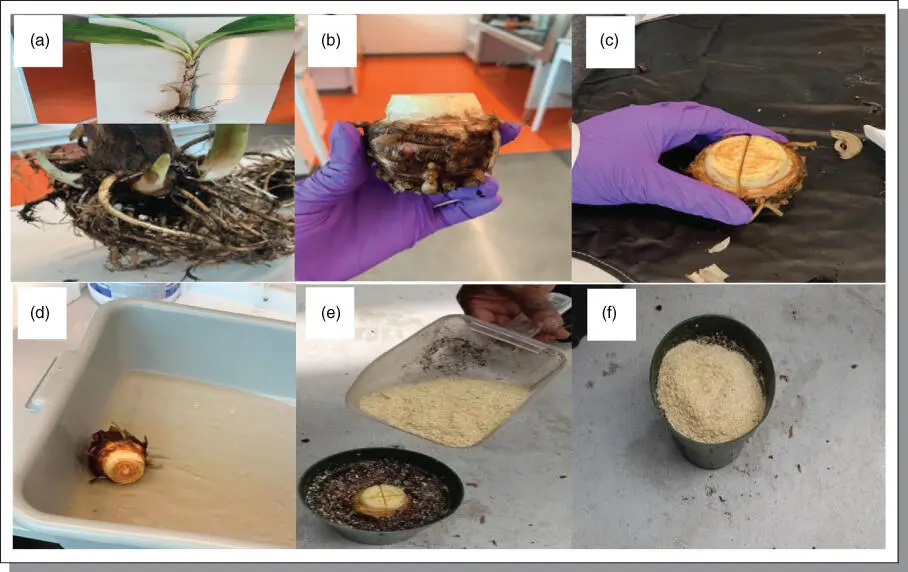
Figure B7.11Flow chart of macropropagation of plantain (Poteau Geant, ABB). (a) = uprooting or harvesting of banana sucker from true‐to‐type mother plant; (b) = shaping of sucker; (c) = cross‐section cutting of the sucker; (d) = sterilization of prepared sucker; (e) = planting of the sucker by placing on treated soil; and (f) = covering of the sucker with sawdust serving as fertilizer.

Figure B7.12Macropropagation experimental output from a plantain accession (Poteau Geant, PG, ABB). (a) = growth rate of macropropagated PG (ABB); (b) = fully macropropagated and grown Poteau Geant ready for transfer to separate plastic pots; (c) = four independently obtained macropropagated PG from pot a; (d) = still pot a, the source of the four separate, showing more growth initiation after the transfer of the initial four plantlets.
1 Abiodun‐Solanke, A.O. and Falade, K.O. (2010). A review of the uses and methods of processing banana and plantain (Musa spp.) into storable food products. Journal of Agricultural Research and Development 9 (2): 1–82. Copy @ 2010, Faculty of Agriculture, University of Ilorin.
2 Chen, X.M., Line, R.F., and Leung, H. (1998). Genome scanning for resistance‐gene analogs in rice, barley and wheat by high‐resolution electrophoresis. Theor Appl Genet. 97: 345–355.
3 Collard, B.C.Y. and Mackill, D.J. (2009). Start codon targeted (SCoT) polymorphism: a simple, novel DNA marker technique for generating gene targeted markers in plants. Plant Molecular Biology Reporter 27: 86–93.
4 Dempewolf, H., Eastwood, R.J., Guarino, L. et al. (2014, 2014). Adapting agriculture to climate change: a global initiative to collect, conserve, and use crop wild relatives. Agroecology and Sustainable Food Systems 38: 369–377.
5 D'Hont, A., Denoeud, F., Aury, J.M. et al. (2012). The banana (Musa acuminata) genome and the evolution of monocotyledonous plants. Nature 488: 213–217. https://doi.org/10.1038/nature11241.
6 Etminan, A., Pour‐Aboughadareh, A., Mohammadi, R. et al. (2016). Applicability of start codon targeted (SCoT) and inter‐simple sequence repeat (ISSR) markers for genetic diversity analysis in durum wheat genotypes. Biotechnol Biotec Eq. 30: 1075–1081.
7 FAO (2009). Agricultural Production Status. Food and Agricultural Organisation http://www.fao.org/faostat.
8 FAO. 2011. The World Banana Forum (WBF): Working together for sustainable banana production and trade. Introductory note. Accessed 23/2/2011. http://www.fao.org/economic/worldbananaforum.
9 FAO. Food and Agriculture Organization of the United Nations. Crop yield. http://faostat.fao.org/site/567/DesktopDefault.aspx?PageID=567#ancor. 2015.
10 FAOStat. 2014. FAO production statistics for banana and plantain 2012. http://faostat.fao.org/site/567/DesktopDefault.aspx?PageID¼567#ancor(accessed on 20 Mar 14).
11 Golicz, A.A., Bayer, P.E., Barker, G.C. et al. (2016). The pangenome of an agronomically important crop plant Brassica oleracea. Nature Communications 7: 13390.
12 Guo, D.L., Zhang, J.Y., and Liu, C.H. (2012). Genetic diversity in some grape varieties revealed by SCoT analyses. Molecular Biology Reports 39: 5307–5313.
13 Hajibarat, Z., Saidi, A., Hajibarat, Z., and Talebi, R. (2015). Characterization of genetic diversity in chickpea using SSR markers, start codon targeted polymorphism (SCoT) and conserved DNA‐derived polymorphism (CDDP). Physiology and Molecular Biology of Plants 21 (3): 365–373.
14 Hamidi, H., Talebi, R., and Keshavarz, F. (2014). Comparative efficiency of functional gene‐based markers, start codon targeted polymorphism (SCoT) and conserved DNA derived polymorphism (CDDP) with ISSR markers for diagnostic fingerprinting in wheat (Triticum aestivum L.). Cereal Research Communications 44 (4): 558–567.
15 IBA (International Banana Association) 2007 Banana facts: nutrition. Accessed 18/04/2007. http://www.eatmorebananas.com/facts/nutrition.html.
16 Igwe, D.O., Afiukwa, C.A., Ubi, B.E. et al. (2017). Assessment of genetic diversity in Vigna unguiculata L. (Walp) accessions using inter‐simple sequence repeat (ISSR) and start codon targeted (SCoT) polymorphic markers. BMC Genetics 18: 98.
17 INIBAP (2003) International Network for the Improvement of Banana and Plantain of Banana‐Food and wealth, www.inibap.org.
18 International Institute of Tropical Agriculture, IITA (2018). https://images.search.yahoo.com/search/images?p=IITA+banana&fr=tightropetb&imgurl=http%3A%2F%2Fblogs.iita.org%2Fwp-content%2Fuploads%2F2018%2F06%2Fslider5-1080x607.jpg#id=429&iurl=http%3A%2F%2Fwww.iita.org%2Fwp-content%2Fuploads%2F2018%2F04%2Fbanana-and-plantain.jpg&action=click
19 Jiang, L. and Zang, D. (2018). Analysis of genetic relationships in Rosa rugosa using conserved DNA‐derived polymorphism markers. Biotechnology and Biotechnological Equipment 32 (1): 88–94. https://doi.org/10.1080/13102818.2017.1407255.
20 Karamura, E., Frison, E., Karamura, D.A., and Sharrock, S. (1998). Banana production systems in eastern and southern Africa: bananas and food security. In: (eds. C. Picq, E. Foure and Frison), 401–412. Montpellier: INIBAP.
21 Karule, P., Dalvi, V., Kadu, A. et al. (2015). A commercial micropropagation protocol for virupakshi (AAB) banana via apical meristem. African Journal of Biotechnology 15 (11): 401–407.
22 Khoury, C.K., Bjorkman, A.D., Dempewolf, H. et al. (2014). Increasing homogeneity in global food supplies and the implications for food security. Proceedings of the National Academy of Sciences of the United States of America 111: 4001–4006.
23 Lamare, A. and Rao, S.R. (2015). Efficacy of RAPD, ISSR, and DAMD markers in assessment of genetic variability and population structure of wild Musa acuminata colla. Physiology and Molecular Biology of Plants 21 (3): 349–358.
24 Li, X., Bai, T., Li, Y. et al. (2013). Proteomic analysis of Fusarium oxysporum f. sp. cubense tropical race 4‐inoculated response to Fusarium wilts in the banana root cells. Proteome Science 11: 41. http://www.proteomesci.com/content/11/1/41(Accesed 20 October 2014).
25 Li, T., Guo, J.E., and Zheng, C.S. (2014). Genetic diversity and construction of fingerprinting of chrysanthemum cultivars by CDDP markers. Journal of Beijing Forestry University 36 (4): 95–101.
26 Mam, A., Sakr, M.M., and Adawy, S.S. (2017). Assessing date palm genetic diversity using different Molecular Markers. Methods Mol Biol. 1638: 125–142.
27 Molina, A.B. and Kudagamage, C. (2002). Report of the South Asia Network on Plant Genetic Resources (SANPGR) meeting held on December 9–11 at Plant Genetic Resources Center (PGRC), Peradeniya, Sri Lanka, 2002/12/09–11 INIBAP‐BAPNET, Los Baños (PHL), p. 7.
28 Montenegro, J.D., Golicz, A.A., and Bayer, P.E. (2017). The pangenome of hexaploid bread wheat. Plant J. 90: 1007–1013.
29 Poczai, P., Varga, I., and Bell, N.E. (2011). Genetic diversity assessment of bittersweet (Solanum dulcamara, Solanaceae) germplasm using conserved DNA‐derived polymorphism and intron‐ targeting markers. The Annals of Applied Biology 159: 141–153.
30 Poczai, P., Varga, I., Laos, M. et al. (2013). Advances in plant gene‐targeted and functional markers: a review. Plant Methods 9: 6.
31 Pollefeys, P., Sharrock, S., and Arnaud, E. (2004). Preliminary Analysis of the Literature on the Distribution of Wild Musa Species Using MGIS and DIVA‐GIS. Montpellier, France: INIBAP http://www.musalit.org/seeMore.php?id¼8616(accessed on 18 Jan 2014), 68pp.
Читать дальше














